 W
WThe screaming hairy armadillo is a species of armadillo also known as the small screaming armadillo, crying armadillo or the small hairy armadillo. It is a burrowing armadillo found in the central and southern parts of South America. The adjective "screaming" derives from its habit of squealing when handled.
 W
WThe culpeo, sometimes known as the zorro culpeo, Andean zorro or Andean fox, is a species of South American fox. Regardless of the name, it is not a true fox but more-closely related to wolves and jackals. Its appearance resembles that of foxes due to convergent evolution.
 W
WThe Chilean dolphin, also known as the black dolphin, is one of four dolphins in the genus Cephalorhynchus. The dolphin is only found off the coast of Chile; it is commonly referred to in the country as tonina.
 W
WThe dusky dolphin is a dolphin found in coastal waters in the Southern Hemisphere. Its specific epithet is Latin for "dark" or "dim". It is very closely genetically related to the Pacific white-sided dolphin, but current scientific consensus holds they are distinct species. The dolphin's range is patchy, with major populations around South America, southwestern Africa, New Zealand, and various oceanic islands, with some sightings around southern Australia and Tasmania. The dusky dolphin prefers cool currents and inshore waters, but can also be found offshore. It feeds on a variety of fish and squid species and has flexible hunting tactics. The dusky dolphin is known for its remarkable acrobatics, having a number of aerial behaviours. The status of the dolphin is unknown, but it has been commonly caught in gill nets.
 W
WThe hourglass dolphin is a small dolphin in the family Delphinidae that inhabits offshore Antarctic and sub-Antarctic waters. It is commonly seen from ships crossing the Drake Passage, but has a circumpolar distribution.
 W
WPeale's dolphin is a small dolphin found in the waters around Tierra del Fuego at the foot of South America. It is also commonly known as the black-chinned dolphin or even Peale's black-chinned dolphin. However, since Rice's work Peale's dolphin has been adopted as the standard common name.
 W
WDarwin's fox or Darwin's zorro is an endangered canid from the genus Lycalopex. It is also known as the zorro chilote or zorro de Darwin in Spanish and lives on Nahuelbuta National Park, the Valdivian Coastal Range in mainland Chile and Chiloé Island. This small, dark canine weighs 1.8 to 3.95 kg, has a head-and-body length of 48 to 59 cm and a tail that is 17.5 to 25.5 cm.
 W
WThe South American gray fox, also known as the Patagonian fox, the chilla or the gray zorro, is a species of Lycalopex, the "false" foxes. It is endemic to the southern part of South America.
 W
WThe Fuegian dog, also known as the Yaghan dog, is an extinct domesticated dog. It was a domesticated form of the wild dog culpeo, unlike other domesticated canids – domestic dogs, domesticated from the gray wolf, and the domesticated silver fox from a melanistic population of the red fox.
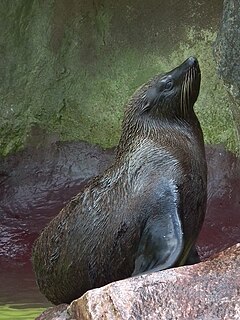 W
WThe South American fur seal breeds on the coasts of Peru, Chile, the Falkland Islands, Argentina, Uruguay and Brazil. The total population is around 250,000. However, population counts are sparse and outdated. Although Uruguay has long been considered to be the largest population of South American fur seals, recent census data indicates that the largest breeding population of A. a. australis are at the Falkland Islands followed by Uruguay. The population of South American fur seals in 1999 was estimated at 390,000, a drop from a 1987 estimate of 500,000 - however a paucity of population data, combined with inconsistent census methods, makes it difficult to interpret global population trends.
 W
WGeoffroy's cat is a small wild cat native to the southern and central regions of South America. It is about the size of a domestic cat. It is listed as Least Concern on the IUCN Red List because it is widespread and abundant over most of its range.
 W
WThe guanaco is a camelid native to South America, closely related to the llama. Its name comes from the Quechua word huanaco. Young guanacos are called chulengos.
 W
WHaig's tuco-tuco, known regionally as the Patagonian tuco-tuco, is a South American hystricognath rodent. Like other tuco-tucos it is subterranean and thus not often observed, although the "tuc-tuc" call of the males can be heard near burrow sites, especially in early morning. Like most species in the genus Ctenomys, C. haigi are solitary, with one adult per burrow.
 W
WHumboldt's hog-nosed skunk, also known as the Patagonian hog-nosed skunk, is a type of hog-nosed skunk indigenous to the open grassy areas in the Patagonian regions of South Argentina and Chile. It belongs to the order Carnivora and the family Mephitidae.
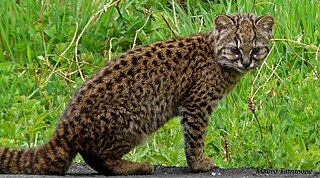 W
WThe kodkod, also called güiña, is the smallest cat in the Americas. It lives primarily in central and southern Chile and marginally in adjoining areas of Argentina. Its area of distribution is small compared to the other South American cats. Since 2002, it has been listed as Vulnerable on the IUCN Red List as the total effective population may comprise less than 10,000 mature individuals, and is threatened due to persecution and loss of habitat and prey base.
 W
WThe South American gray fox, also known as the Patagonian fox, the chilla or the gray zorro, is a species of Lycalopex, the "false" foxes. It is endemic to the southern part of South America.
 W
WThe Magellanic tuco-tuco is a species of rodent in the family Ctenomyidae. It is found in Argentina and Chile. Its natural habitat is subtropical or tropical dry lowland grassland. It is also known as the cururo by the Ona culture of Tierra del Fuego.
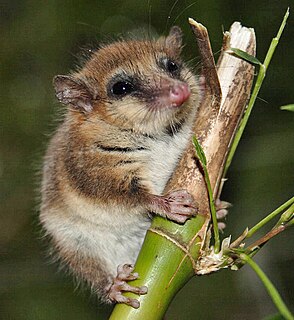 W
WThe monito del monte or colocolo opossum, Dromiciops gliroides, also called chumaihuén in Mapudungun, is a diminutive marsupial native only to southwestern South America. It is the only extant species in the ancient order Microbiotheria, and the sole New World representative of the superorder Australidelphia. The species is nocturnal and arboreal, and lives in thickets of South American mountain bamboo in the Valdivian temperate rain forests of the southern Andes, aided by its partially prehensile tail. It eats primarily insects and other small invertebrates, supplemented with fruit.
 W
WThe elegant fat-tailed mouse opossum, also known as the Chilean mouse opossum, is an opossum from central Chile. The type species of Thylamys, it was first described by English naturalist George Robert Waterhouse in 1839. This medium-sized opossum is characterized by black rings around the eyes, white limbs, gray to light brown coat, lighter flanks and underbelly and a thick 12.7–14.6 centimetres (5.0–5.7 in) long tail covered with hairs. It is crepuscular and lives in nests in tree hollows or under rocks and roots. This opossum feeds mainly on arthropods and larvae apart from fruits. Litter size is typically between 11 and 13. The elegant fat-tailed opossum can occur in a variety of habitats – from cloud forests to chaparrals. The IUCN classifies the opossum as least concern.
 W
WThe southern river otter is a species of otter that lives in Chile and Argentina. Although called a "river otter", it inhabits both marine and freshwater environments. It sometimes is considered a subspecies of Lontra canadensis. The southern river otter is listed as endangered, due to illegal hunting, water pollution, and habitat loss.
 W
WThe Pampas cat is a small wild cat native to South America. It is listed as Near Threatened on the IUCN Red List as habitat conversion and destruction may cause the population to decline in the future.
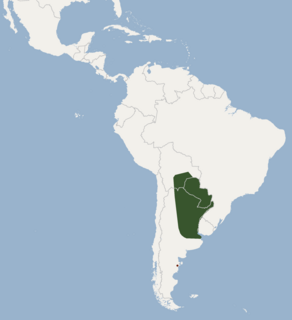 W
WThe Patagonian bonneted bat, also called the Patagonian dwarf bonneted bat, is a species of free-tailed bat found in Argentina, Bolivia and Paraguay.
 W
WThe Patagonian mara is a relatively large rodent in the mara genus Dolichotis. It is also known as the Patagonian cavy, Patagonian hare, or dillaby. This herbivorous, somewhat rabbit-like animal is found in open and semiopen habitats in Argentina, including large parts of Patagonia. It is monogamous, but often breeds in warrens shared by several pairs.
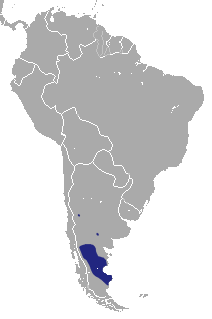 W
WThe Patagonian opossum (Lestodelphys halli) is the sole species in genus Lestodelphys.
 W
WThe Patagonian weasel is a small mustelid that is the only member of the genus Lyncodon. Its geographic range is the Pampas of western Argentina and sections of Chile. An early mention of the animal is in the Journal of Syms Covington, who sailed with Charles Darwin on his epic voyage aboard HMS Beagle.
 W
WThe pichi, dwarf armadillo or pygmy armadillo is an armadillo native to Argentina and Chile. It is the only living member of the genus Zaedyus, and the only armadillo to hibernate.
 W
WThe small big-eared brown bat is a species of vesper bat in the family Vespertilionidae. It can be found in the following countries: Argentina, Bolivia, Brazil, Chile, Colombia, Ecuador, Peru, Uruguay, and Venezuela.
 W
WThe southern mountain cavy is a species of South American rodent in the family Caviidae.
 W
WThe southern myotis is a species of vesper bat. It is found only in Argentina.
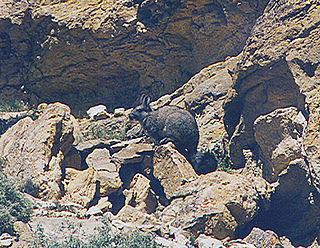 W
WWolffsohn's viscacha is a rare species of rodent in the family Chinchillidae. This species occurs in southwestern Argentina and adjacent Chile.